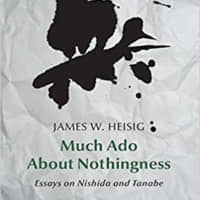"Philosophical ideas which consistently fall dead upon the ears of those untutored in the texts have no business calling themselves philosophy," James Heisig boldly declares at the outset of this collection of 14 scholarly essays exploring diverse aspects of the thinking of two of the founders of the Kyoto School, Kitaro Nishida (1870-1945) and Hajime Tanabe (1885-1962).
Much Ado About Nothingness, by James Heisig.
451 pages
CHISOKUDO PUBLICATIONS, Philosophy.
Heisig variously argues that Nishida's ideas on the unity of consciousness and external reality connect to the worldview of some medieval Western philosophers, or muses on how Nishida's famous "logic of place" link to ideas on theatrical space in the work of medieval noh master Zeami Motokiyo (1363-1443).
On more contemporary themes, Heisig ponders how a philosophy of nothingness — and its desire to offer understanding of the world around us — might lead to a greater appreciation of the Earth and its ecological fragility. Tanabe's concept of the "logic of the specific," meanwhile, is employed to provide a critique of the modern notion of the global village.
The desire to link the philosophy of nothingness with broader intellectual and artistic themes is a noble one, but the general reader may struggle slightly with Heisig's abstract style. Heisig repeatedly remarks on his own frustration with Nishida's philosophical writings, that they rarely offer everyday examples, telling metaphors or poetic language. A non-specialist reader is likely to rather concur that what the world of "nothingness" truly needs is an infusion of tangible reality and vividly poetic style.



















With your current subscription plan you can comment on stories. However, before writing your first comment, please create a display name in the Profile section of your subscriber account page.